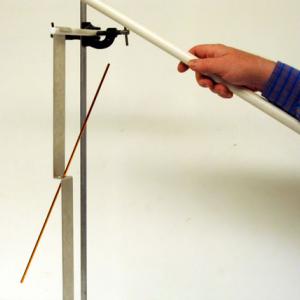College of Liberal Arts & Sciences
5A22.12 - Electroscopes
4 kinds of electroscopes are shown. The Braun electroscope ( large round one ) and the large demo electroscope see the most use. The gold leaf electroscope is very sensitive and is only used when measuring very small amounts of charge.
Make sure to clean the large electroscopes with alcohol before using as the dust and oil from fingers will have a dramatic effect on how these keep a charge. Be careful bringing a charged rod to the large square plate on the large electroscope as too much charge will cause the vane to swing too far and discharge itself. Bring a charged rod near the top of the large demo electroscope with the copper colored vane, where it is folded over the Teflon support. Trying to bring the rod toward the middle of the electroscope will only result in throwing the copper tube vane off its supports.
Also see the 5-00.00, "Support Equipment used for Electricity and Magnetism" files.
- Thomas B. Greenslade Jr., "A Hair-Raising Demonstration", TPT, Vol. 58, #4, April 2020, p. 242.
- John Stewart, Stephen Skinner, and Gay Stewart, "The Leaf Electroscope: A Take-Home Project of Unexpected Depth", TPT, Vol. 51, #9, Dec. 2013, p. 520.
- Nuri Balta, "Can Like Charges Attract Each Other?", TPT, Vol. 50, #7, Oct. 2012, p. 400.
- Walter Connolly and Hyam Kruglak, "A Simpler Soft-Drink-Can Electroscope", TPT, Vol. 28, #9, Dec. 1990, p. 620.
- R. D. Edge, "Electrostatics with Soft-Drink Cans", TPT, Vol. 22, #6, Sept. 1984, p. 396.
- Burton Brody, "Repairing Gold Leaf Electroscopes", TPT, Vol. 14, #6, Sept. 1976, p. 374, also A Potpourri of Physics Teaching Idea - Tricks of the Trade, p. 352.
- James Mahoney, "Apparatus for Teaching Physics: Electroscope Discharge Rate", TPT, Vol. 10, #9, Dec. 1972, p. 534, also A Potpourri of Physics Teaching Ideas - Electricity and Magnetism, p. 132.
- Jack D. Foster, Charles M. Long, and Thomas D. Miner, "Apparatus for Teaching Physics: A Comparative Evaluation of Electroscopes", TPT, Vol. 6, #7, Oct. 1968, p. 370.
- William J. Muha, "Apparatus for Teaching Physics: Electroscope Shadowgraph", TPT, Vol. 6, #4, Apr. 1968, p. 179, also A Potpourri of Physics Teaching Ideas - Electricity and Magnetism, p. 131.
- Thomas B. Greenslade, Jr., "Zeleny Electroscope", AJP, Vol. 92, #12 Dec. 2024, p. 917.
- Nobuo Naba and Zengoro Kawai, "A Leaf Electrometer Discriminating the Polarity of Charge", AJP, Vol. 40, #12, Dec. 1972, p. 1870.
- D. Rae Carpenter Jr. and Richard B. Minnix, "E-137. Straw Electroscope", DICK and RAE Physics Demo Notebook, 1993.
- G. D. Freier and F. J. Anderson, "Ea-3", A Demonstration Handbook for Physics.
- Richard Manliffe Sutton, "E-4", Demonstration Experiments in Physics.
- Robert A. Morse, "Laboratory Activity 2: Electroscopes", Teaching about Electrostatics, p. 3 - 5.
- George M. Hopkins, "Frictional Electricity", Experimental Science, p. 390.
- George M. Hopkins, "Frictional Electricity", Experimental Science, p. 361.
- Carson I. A. Ritchie, "Electroscope", Making Scientific Toys, p. 145.
- David Kutliroff, "76, The Electroscope as a Demonstration Tool", 101 Classroom Demonstrations and Experiment For Teaching Physics, p. 167.
- "Detector For Slight Electrical Charges", The Boy Scientist, p. 86.
- R. A. Ford, "The Electroscope", Homemade Lightening, p. 96.
- R. A. Ford, "Electroscope Anomalies", Homemade Lightening, p. 104.
- "47. Electroscope", The Exploratorium Science Snackbook.
- Recipe No. 90, "Giant Electroscope", Exploratorium Cookbook II.
- Grant Mellor, "3. Here a Charge, There a Charge", Flying Tinsel, 1993, p. 16 - 19.
- Grant Mellor, "2. Instant Tinsel Electroscope", Flying Tinsel, 1993, p. 12 - 15.
- Rudolf F. Graf, "Building and Using a Leaf Electroscope", Safe & Simple Electrical Experiments. p. 11.
- Borislaw Bilash II, “Charging Up Matter“, A Demo A Day – A Year of Physical Science Demonstrations, p. 272.
- Joseph Frick, "# 240 & 241 - Straw and Gold-Leaf Electrometers & Andriessen's Very Sensitive Gold-Leaf Electrometer", Physical Technics: Or Practical Instructions for Making Experiments in Physics and the Construction of Physical Apparatus with the Most Limmited Means, p. 259 & 260.
Disclaimer: These demonstrations are provided only for illustrative use by persons affiliated with The University of Iowa and only under the direction of a trained instructor or physicist. The University of Iowa is not responsible for demonstrations performed by those using their own equipment or who choose to use this reference material for their own purpose. The demonstrations included here are within the public domain and can be found in materials contained in libraries, bookstores, and through electronic sources. Performing all or any portion of any of these demonstrations, with or without revisions not depicted here entails inherent risks. These risks include, without limitation, bodily injury (and possibly death), including risks to health that may be temporary or permanent and that may exacerbate a pre-existing medical condition; and property loss or damage. Anyone performing any part of these demonstrations, even with revisions, knowingly and voluntarily assumes all risks associated with them.

